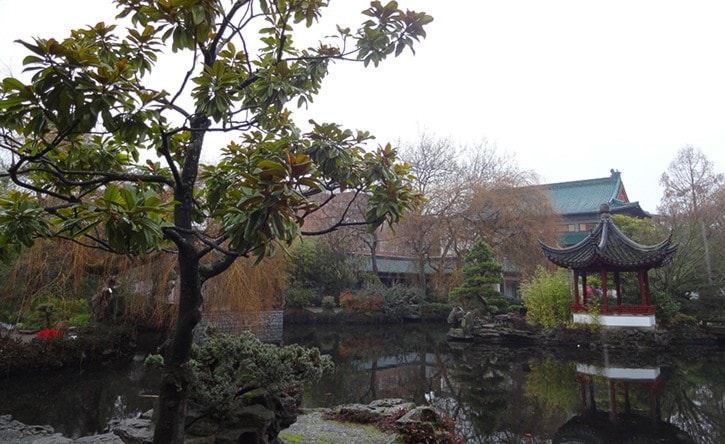Over the Christmas break, we had the opportunity to tour the Dr. Sun Yat-Sen Classical Chinese Garden in Vancouver. I have been meaning to get there for quite some time. It was recently named the world’s top city garden by National Geographic and garden of the year by the Garden Tourism Council of Canada.
The garden really is fantastic! It’s not huge; however, it is completely foreign. Classical Chinese gardens date from the Ming Dynasty (1368-1644). The architecture of the buildings is amazing. They were built by craftsmen from China in the traditional fashion, using no nails, screws or glue. They are meant to blend in with the natural world. You really need to see it in person. No details are spared. The roofing tiles along the edges are all stamped with characters, including the lucky bat. When it rains, the water is channeled and led to drip in a water curtain from the eaves into the courtyards below. The architecture of the gardens is considered one of the four main components of the classical garden, the other three elements being rock, water and plants.
The classical gardens feature asymmetrical arrangements of water features, rocks, plants, pathways, corridors and vistas. Everything is meant to be in balance with one another, yin and yang. Imported water-worn limestone functions as the backbone of the gardens, creating the feel of false mountains. The special limestone is thought to attract and invite lucky spirits and other supernatural powers into the garden.
A large pond in the middle of the garden complex ties the landscape together. The pond water colour is deliberately left jade green. This darker colour symbolizes the tranquility and better reflects the rest of the garden adding another dimension to the visual experience. Water is part of the living pulse of the garden and its soft tone balances that of the hard rock skeleton.
Other living components of the garden are the incredible plants. Most appear to be of Chinese origins; however, they made a point of incorporating some native Canadian plants to symbolize the bridging of the two cultures. By tradition, larger trees have been chosen for the wide open spaces and smaller plants were chosen for the smaller courtyards. The gardens also incorporate the three friends of winter: pine, bamboo and a winter flowering plum tree. They symbolize, respectively, the human virtues of strength and eternity, resiliency and diversity, and, finally, the triumphal rebirth.
Actually constructed the year before Expo 86 in Vancouver, it opened to the public that April. The gardens are named after Dr. Sun Yat-Sen, who was actually a West-trained medical doctor. He spoke in Vancouver at and near the garden site for several months in the early part of the 20th century regarding the overthrow of the Chinese emperor. He was a revolutionary, the first president and founding father of the Republic of China. He was not a communist per se. If you have some spare time this winter, the history of China in the early part of the 20th century is quite fascinating. When reading about these kinds of things I am always thankful to my forefather for settling here in the peaceful “wild” west.
Evan Davies own Beltane Nursery at 2915 Highway 3 in Erickson.
